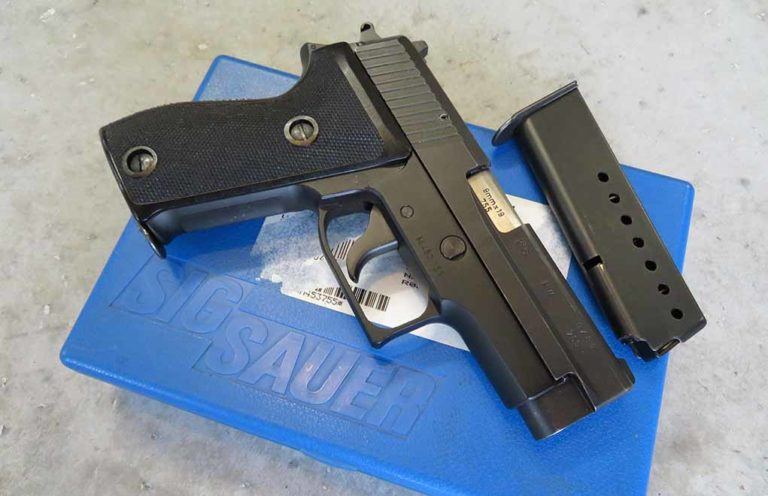
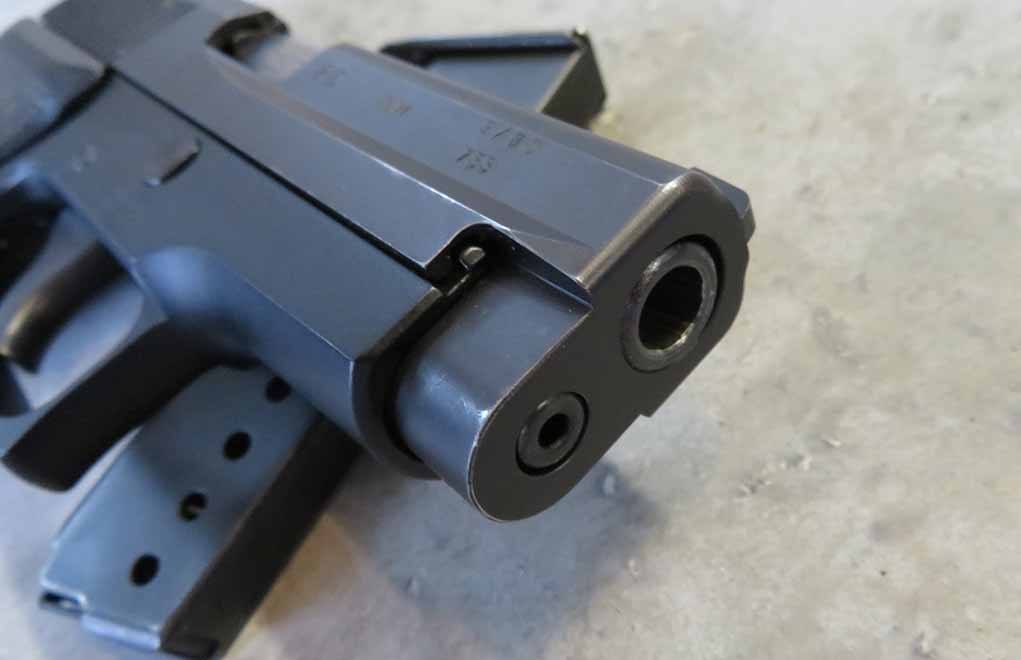
Affordable and effective, the West German-built P6 continues to be a bargain worth hunting down.
P6 Vs. P225
- P6 has a heavier 24-pound mainspring.
- Its rollmarks are next to the ejection port and include the police department it was sold to.
- The feed ramp on the original P6 was designed for FMJ ammunition.
- Notch on the hammer was designed to bend or break to avoid a discharge if the pistol was dropped.
I did not expect to be drawn into a cult. But that’s what happened. In 2000, Germany’s police departments were dumping their P6 pistols on the surplus market. There were loads of surplus SIG SAUER P6 pistols suddenly available. Back then, a double-stack 9mm pistol was on everyone's bucket list.
Why would you want a 9mm that held only 8+1 rounds when 15+1 and 17+1 capacity pistols were available? Think girth. I have average-size hands and some double-stack 9mm pistols can be a chore to grasp comfortably. I’ve always preferred thin-gripped pistols for two reasons: I can grip the pistol better and I usually can shoot them better. When I saw a 9mm SIG SAUER P6 for about $350 I was interested. When I picked it up out of its bright blue plastic box and held it, I immediately knew the gun was going home with me.
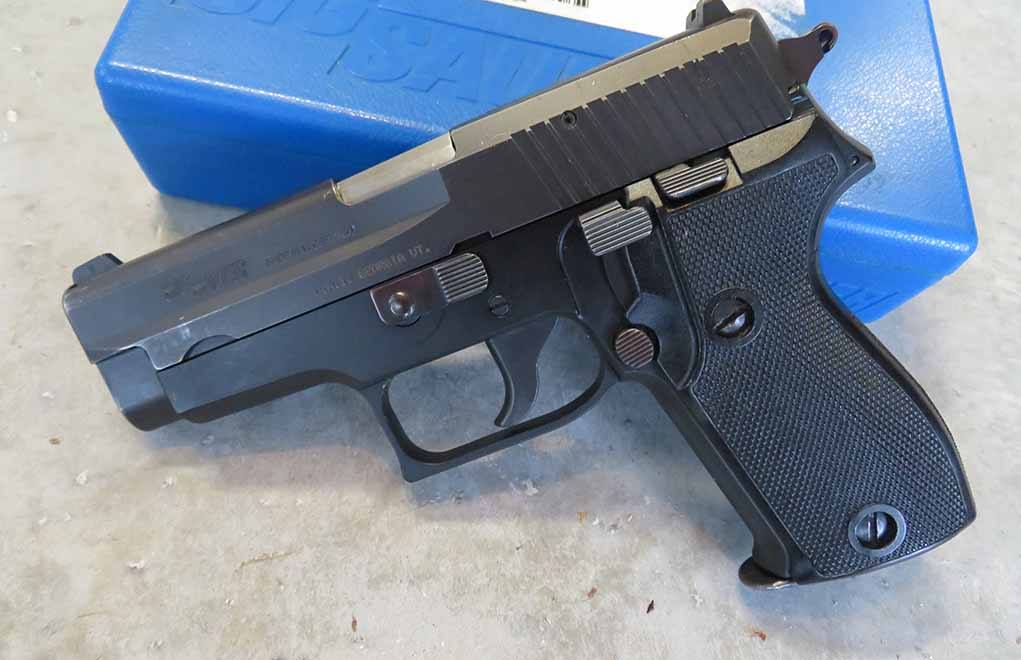
The grip was comfortable and easy to control. The P6 was compact yet felt like a full-size pistol. But then there was the trigger, a long stroke that tested finger muscles. It was not as heavy as the trigger pull of a surplus Polish P-64, but in the same neighborhood. I told myself springs were made to be replaced and left with the P6 under my arm. I would soon find out the P6 was an efficient single-stack nine, and little did I know I had just joined the tribe called SIG. I would soon learn why these fantastic pistols garner such a cult-like following. I had become a SIG initiate.
Get More Info On Sig Sauer Guns
The history of the P6 is like many firearms built for the military or law enforcement: There is a need to sharply cut the production cost of the weapon, yet ensure it is reliable, safe, accurate and easy to operate. In the mid–1970s during the height of the Cold War, when Germany was divided into East and West Germany, the West German police force decided to replace its aging handguns and created a set of specifications for a new pistol. The German police were carrying a Walther PP chambered in .32 ACP. That pistol had been introduced in 1929. It was a good pistol, but was dated and chambered an anemic cartridge. The German police wanted a similar-sized pistol, only chambered in 9mm.
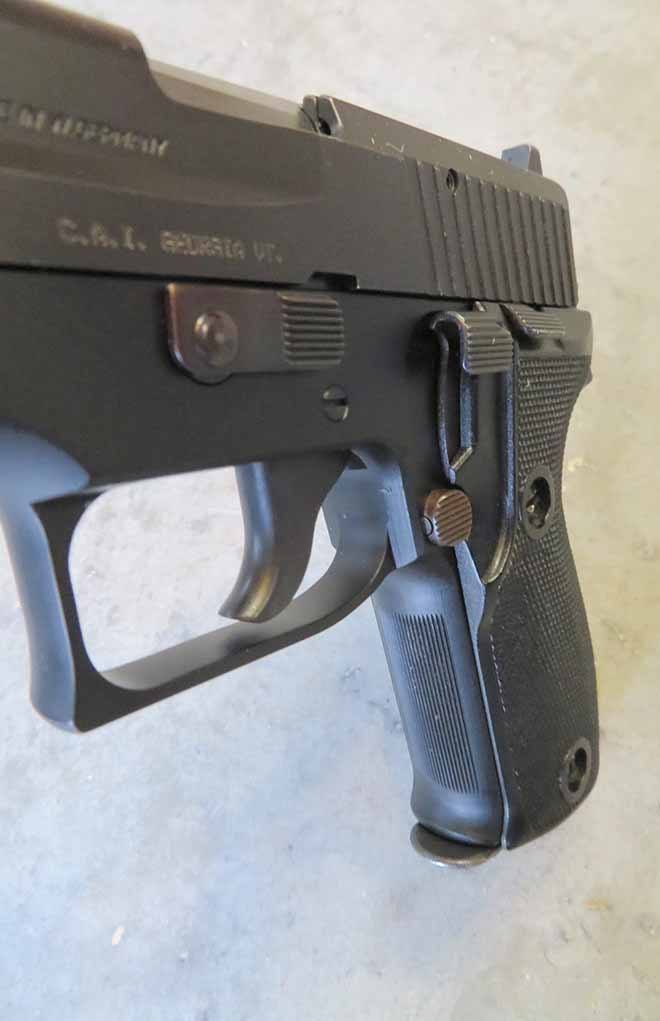
All the big players — Walther, SIG SAUER and Heckler & Koch — ramped up to develop a new pistol that would meet the spec. Back then, steel stamping was a manufacturing method that greatly reduced material and labor cost. Walther offered up the P5, which was basically an up-dated World War II-era P38. Heckler & Koch overthought the German police specifications and created the P7. This was a compact 9mm with a squeeze cocker, and gas-delayed blowback locking action. The P7 would also become revered among semi-automatic pistol aficionados, but it turned out to be too expensive to build and the German police passed. SIG presented the P225, which was a slimmed-down version of its P220. The P225 used all the features of the P220 but in a more compact size. (The P225 is 6.9 inches long and has a 3.6-inch barrel while the P220 sports a 4.4-inch barrel.) At its widest point, the P225 measures 1.3 inches while the grip is 1.2 inches thick. Unloaded it weighs 30.5 ounces.
The P220 was unique as it used a modified Browning link system, which has since been copied by numerous pistol manufacturers. The SIG system locks the barrel and slide together using an enlarged breech section on the inlet of the barrel lug. Upon firing, the barrel and slide move rearward together, then the barrel tilts as the slide continues rearward to eject the empty case and scrapes a fresh round from the magazine, loading it into the chamber. The P220 also uses a double-action/single-action (DA/SA) trigger system, where the first shot is fired double action and all subsequent shots are fired single action. What SIG added to the P220 was a decocking lever that allowed the right-handed user to decock the hammer and place the pistol in double-action mode.
The P225 had all these features but the real innovation was the way the pistol was manufactured. The slide was made of stamped steel and welded together with a steel breechblock pinned into the slide. It was inexpensive to produce and that ultimately was one of the reasons the German police purchased it.
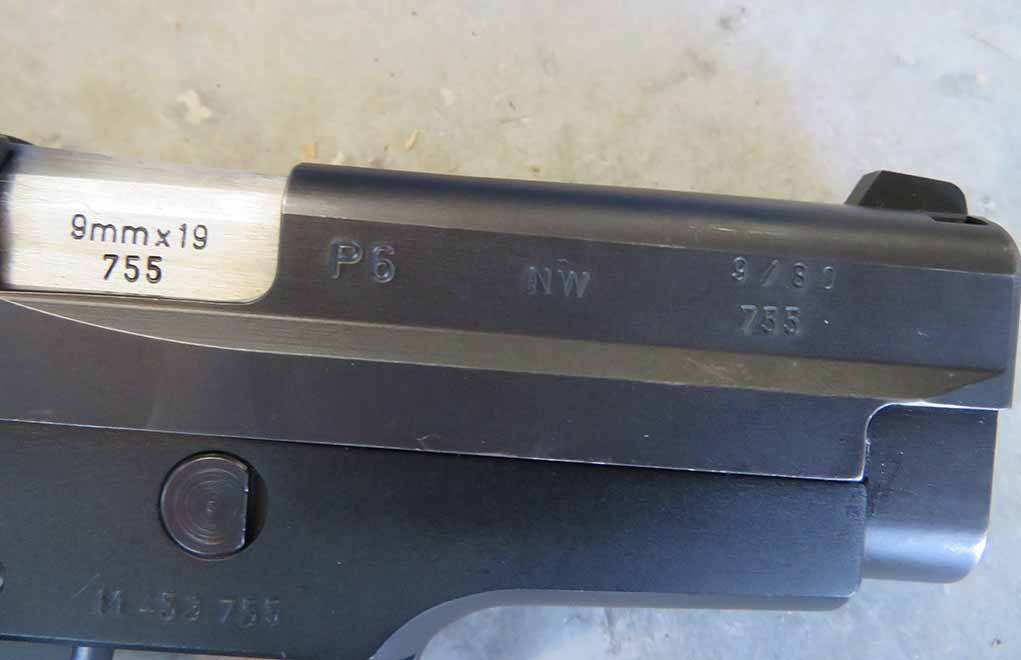
Safety features on the P225 included an automatic firing pin block that is deactivated when the trigger is pressed fully rearward. It also incorporated a drop safety. The SIG P225 was safe, accurate, reliable, inexpensive and chambered in 9mm. The German government approved pistols for sale to police and designated the models with a “P” for police (Polizei) and, after the P225 was configured to West German standards, it was called the P6.
So what are the differences between the P225 and P6? The P6 has a heavier 24-pound DA trigger pull. That was the trigger pull I first experienced with the P6. A long, heavy trigger pull was considered an added safety feature. It takes real effort to pull it. The P6 mainspring weight was increased to 24 pounds from the 18-pound mainspring in the P225. Perhaps the most noticeable difference is the odd-looking spur hammer, specification for which came directly from the German pistol standard. The notch was intentionally designed to bend or snap off due to an accidental drop. It serves as a visual indicator of a dropped gun incident.

Another difference with the P6 was the barrel feed ramp. The shape of the P6’s ramp differed slightly from the P226. The P6 was designed to use FMJ ammunition — the standard ammo of the time. You might find your P6 doesn’t tolerate modern JHP ammunition.
Lastly, the markings on the P6 differ from the P225. The P6 is void of the SIG P225 rollmarks and has “P6” stamped on the right side of the slide just forward of the ejection port. West German agency markings can also be found on the right side of the slide and are typically two to three uppercase letters. Mine reads “NW” for Nordrhein-Westfalen state police. Toward the muzzle is the date code production in the form of month and year. Mine reads “9/80” which indicates a pistol proofed in September 1980. The side and barrel also share the same last three digits of the serial number, which tells me my P6 has all matching serial numbers.
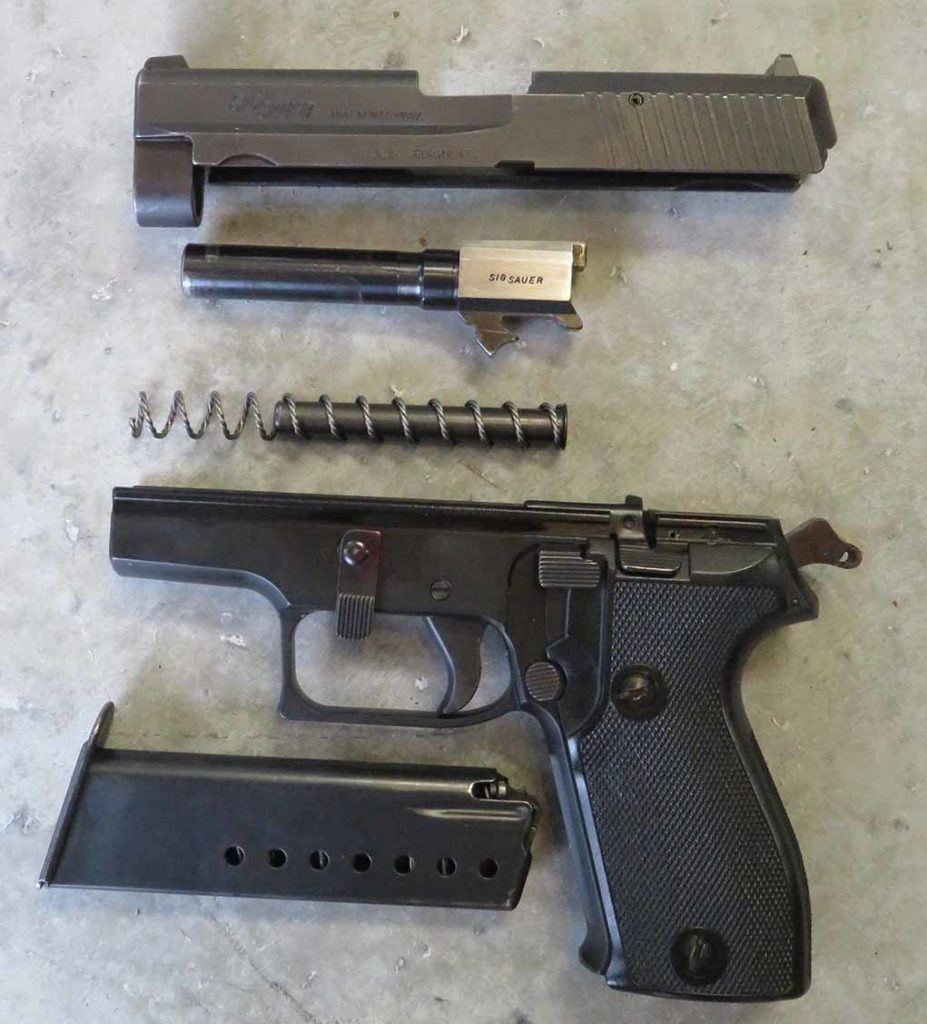
When I first handled the P6 I experienced its superbly designed grip. It’s thin, yet has some palm swell, which was an improvement over the plain-checkered plastic grip. It’s compact and points well, and tears down like most SIG DA/SA pistols, which means disassembly for cleaning is fast, simple and intuitive. It is an older pistol so you won’t find a captured recoil spring like you will on a modern model. The sights are modern, meaning they are large and allow you to easily acquire the target. As I wrote earlier, the trigger was the feature that dated the P6. Trigger reach was excessive and took too much effort to fire in DA. In SA, pull was about half the weight of the DA pull.
My P6 shows no preference for bullet type and in fact chews through JHPs as easily as it does FMJs. After I purchased the P6 I carried the pistol concealed for a while and retired it only because I was afraid a part would break, and I wouldn’t be able to find a replacement or the parts would cost as much as a new polymer-frame pistol. I’ve had various SIG handguns pass through my hands and the P6 is the one I’ve kept.
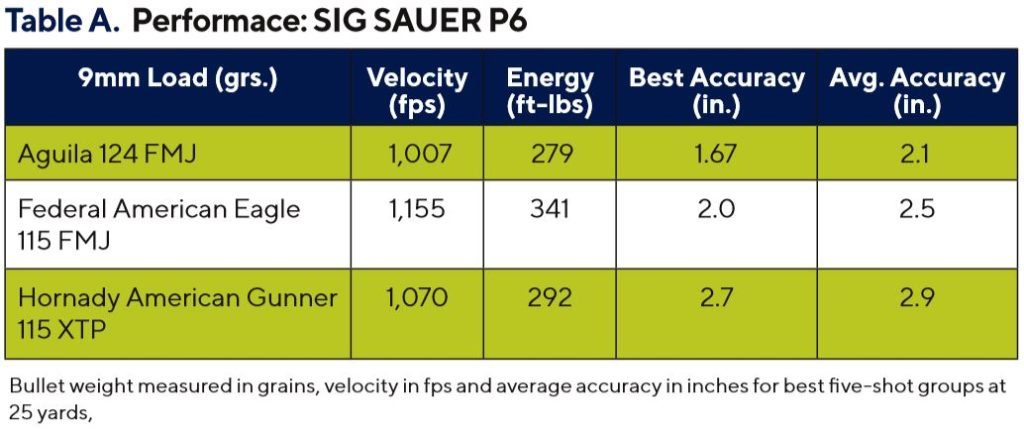
I tend to speak with reverence about the P6 as do others. It’s compact and yet performs like a full-size pistol. As us proud members of the SIG cult know all too well, there are many reasons why the P225 was reintroduced!
SIG SAUER P6 (P225) SPECS
CALIBER: 9x19mm Parabellum
ACTION: Semi-Automatic, short recoil-operated, locked breech
TRIGGER: Single-action/double-action
BARREL LENGTH: 3.9 in.
OVERALL LENGTH: 7.1 in.
WEIGHT: 30.4 oz. (unloaded)
GRIP: Checkered polymer
SIGHTS: Fixed, notch rear/blade front
FINISH: Blued
CAPACITY: 8+1, single-stack magazine
Raise Your Sig Sauer IQ: Enhance your shooting precision with our 62 MOA Targets, perfect for rifles and handguns. Crafted in collaboration with Storm Tactical for accuracy and versatility. Subscribe to the Gun Digest email newsletter and get your downloadable target pack sent straight to your inbox. Stay updated with the latest firearms info in the industry.
Next Step: Get your FREE Printable Target Pack

![Best Concealed Carry Guns In 2025 [Field Tested] Wilson Combat EDC X9S 1](https://gundigest.com/wp-content/uploads/Wilson-Combat-EDC-X9S-1-324x160.jpg)


![Best 9mm Carbine: Affordable PCCs [Tested] Ruger Carbine Shooting](https://gundigest.com/wp-content/uploads/Ruger-Carbine-Shooting-100x70.jpg)
![Best AR-15: Top Options Available Today [Field Tested] Harrington and Richardson PSA XM177E2 feature](https://gundigest.com/wp-content/uploads/Harrington-and-Richardson-PSA-XM177E2-feature-100x70.jpg)
